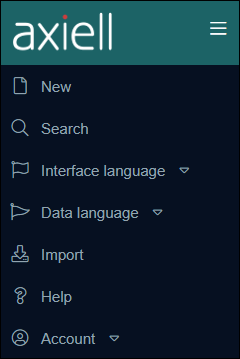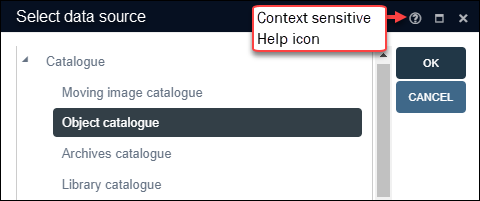The Axiell Collections Help
Our aim with this Help is to document the functionality available in Axiell Collections and to demonstrate how to use it. For the most part we do not advise you how to document a collection. Our software is designed to assist collections professionals to document their items and processes according to the world's best cataloguing standards, and we believe that you know better than we do how to document your own organization's collection.
However, we appreciate that some users may benefit from advice about what data to enter when documenting collection items and processes, and to that end we provide a supplementary Managing your collection section.
The Axiell Collections Online Help is a modern, responsive website designed to adapt to the device on which it is viewed. A side menu simplifies navigation and provides context for the current page (on small devices the menu is hidden and slides out as required); discoverability is facilitated through a powerful search utility.
Note: Although the Help can be viewed on a device with a small screen, Axiell Collections itself is designed to be viewed on a desktop monitor and many of the screenshots in the Help capture a desktop display of Collections; some of the detail in these images may be difficult to see on a small screen.
When working with Axiell Collections the Online Help can be accessed in several ways:
- Click
 in the Main menu:
in the Main menu:The Help's Welcome page will display in your device's default web browser.
- Click the Context sensitive Help icon in the Title bar of a dialogue box, e.g.:
In this example the Help will open in your device's default web browser and display details about the Select data source box.
Axiell Collections is a flexible, powerful and comprehensive collections management system and thorough documentation of all its features and functions inevitably results in a large amount of content. Perhaps the greatest challenge with a large Help system is discoverability: how do users find the information they need when they need it?
There is no simple answer to this question, not least because it's necessary to accommodate different types of user and levels of familiarity with the content: we don't all approach the hunt for answers in the same way.
Our solution is to implement a number of strategies, notably through structuring the content, cross-referencing, duplication of content, FAQs and, critically, through search:
- Structure
User and Administration content is separate. The user section provides all the information a user needs to work with Collections. The two most important sections are:
- The User Interface (UI): if you need to know what a feature of the UI does, look here first. Every button, menu option, element in each View is described and, where appropriate, linked to a topic dedicated to explaining it fully.
- Working with records: here you will find all you need to know about creating records and managing your data. Detailed guidance is provided about everything from creating records (individually, in bulk, through import) through to linking records, searching, sorting, grouping, reporting, and more.
- Cross-referencing: links throughout the documentation guide users to more details and related topics.
- Duplication of content: where appropriate, content is replicated in two or more locations.
- FAQs: the FAQ section attempts to capture the type of question a user might ask when looking for information - it is a quick way to navigate to more details about an issue.
- Search: the Collections Help is built around a powerful search engine, using indexing and keywords.
Taking some time to become familiar with the Help is certainly useful - browse the Help to see how it has been organized. And pass on any suggestions for further improving discoverability. We are always looking for ways to make the Help work better for our users.
Axiell Collections is a web-based Collections Management System (CMS) designed to manage the digital and physical collections of Archives, Libraries (special libraries) and Museums. These three types of collection have much in common but also specific collections management needs, and to meet those needs Axiell Collections is available in three distinct models:
- Archive
- Library
- Museum
Our CMS is also intended for multi-discipline collections, and various combinations are available:
- Archive+Library
- Archive+Museum
- Library+Museum
The XPlus model is intended for organizations with all three types of collection:
- Archive+Library+Museum
Collections is also customizable and can be tailored to the collections management requirements of any institution that adopts it.
The version of Axiell Collections used in this documentation to demonstrate how to work with the system is multilingual and designed for an organization with archive, library and museum collections. As a result you may find that your organization's implementation of Axiell Collections includes different data sources![]() The management of a collection can involve a vast amount of information about objects / items / books, people and organizations, events, administration and more. This information is stored as records in data sources. Each data source stores a specific type of information: details about collection items, people, events, loans, and so on. to those described in this documentation, and that fields are named differently.
The management of a collection can involve a vast amount of information about objects / items / books, people and organizations, events, administration and more. This information is stored as records in data sources. Each data source stores a specific type of information: details about collection items, people, events, loans, and so on. to those described in this documentation, and that fields are named differently.
Even though the screenshots may not exactly match your implementation of Collections and some screen elements (fields, panels, etc.) may be named differently, the techniques demonstrated in this documentation are relevant to all recent versions of Collections.
There can be several ways to accomplish a task in Collections - clicking a button, using a keyboard short cut, for instance. The first time a process is documented in this Help, every method to complete it is given. Thereafter only one method is given (we do not list every method to create a new record every time a process instructs you to create a new record). Be aware that there are often several ways to accomplish the same task.
Feedback
Most pages in this Help include an option at the bottom of the page to provide feedback. If a page contains errors of any sort, is unclear, or you have additional details that could benefit other users, please help us improve it by using the feedback option.



